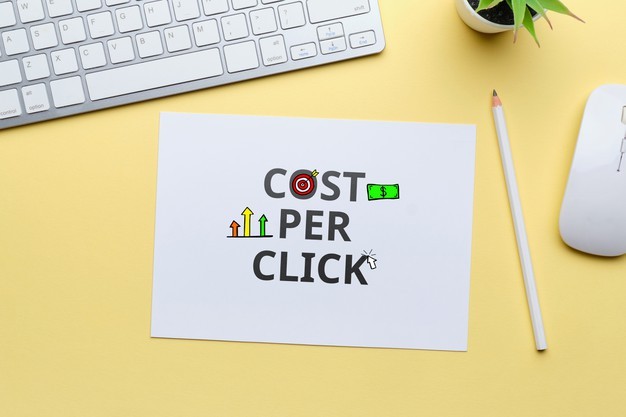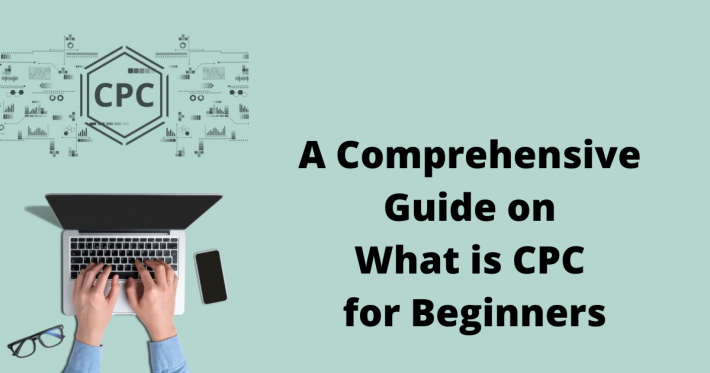When running PPC or social media campaigns, you’ll want to keep an eye on key indicators like cost per click to see how you can reach out to more people for less money.
A crucial digital marketing measure is the cost per click, which is the amount you spend when someone clicks on your ad. What is CPC and how it works is a key factor when targeting customers online. It gives you insight into how much your company costs for a click on your ad, as well as inspiration, to reduce your advertisement CPC.


The actual price an advertiser would pay for each click on a pay-per-click (PPC) marketing campaign is referred to as the cost per click (CPC).
In other words, the cost per click (CPC) is the rate that marrketers are expected to pay publishers when their advertisements are clicked.
If you pay careful attention, you’ll find that CPC is often discussed in conversations regarding paying ads. Paid advertising is a simple and fast form of digital marketing that produces instant results. It is often used when the goal is to generate more leads, get improved visibility, and get more traffic.
The effectiveness of a paid commercial (PPC campaign) is determined by two crucial factors. The click-through rate (CTR) is one, and the cost per click (CPC) is the other. It is important to have a higher CTR and a lower CPC in order to reach a higher ROI.
In this post, we’ll look at what CPC is and how to run a successful PPC campaign.
What is CPC, and What is CPC Advertising?

In the simplest words, CPC, or Cost per Click, refers to the real cost of paid advertising campaigns, also known as PPC. It is the fee that the advertiser pays for each click on a PPC ad on platforms like Google AdWords and Bing Ads.
The CPC is measured based on a variety of parameters, including the highest price, quality ranking, and the ad rank of other advertisers that have submitted bids for the same keyword.


It’s a significant measure because clicks and costs will easily add up, and if the CPC is too big, advertisers won’t be able to get a return on their advertisement expenditures, or ROI. Giving attention to the CPC promotional formula will help you understand what CPC is in Digital Marketing.
The formula used to calculate CPC is:
Competitor Ad Rank/Your Quality Score + 0.01 = Actual CPC
When you run a paid ad campaign for Google AdWords, you’re normally asked to reveal the maximum cost per click (MCPC) that you’re able to pay for certain keywords. Advertisers, on the other hand, are not necessarily required to pay this fee. They will be paid either the same as or less than the MCPC.
CPC in Google Adwords

Your offer is equivalent to other marketers’ offers because Google ads are built on an auction scheme. The real sum you pay, referred to as the CPC, will never surpass the MCPC. What is CPC in Google AdWords and how much CPC you would be paid is mainly determined by the following three factors:
- Your closest competitors ad rank
- Your Maximum bid
- Your Quality score
Since the cost of clicks adds up quickly, understanding what CPC in Google Ad Words means is crucial. As a result, you won’t be able to produce a high return on investment. Your target should be to get high-quality traffic at a low cost-per-click (CPC) price. It’s definitely a smart thing to figure out what is CPC in your business when you’re doing this.
If you’re spending more than your rivals, this will inform you. Depending on the market, the average CPC varies. The average CPC for financial services and industrial machinery, for example, is very high.
The ROI in AdWords is determined through two factors:
- Amount of money spent on the clicks
- Quality of traffic which is obtained from the clicks
The aim is to get the kind of traffic that increases the business’s real value. The average CPC is calculated by a variety of factors, including:
- The industry in which the business operates
- Organizational structure
- Networks that the business also advertises
CPCs are higher in sectors that are more competitive or have a higher rate of conversions (in terms of price), such as manufacturing machinery, business applications, or high-priced facilities in the financial and legal industries.


Importance of CPC in Adwords
The cost per click (CPC) is the metric that determines if a paid search campaign is successful. It also displays the expense of AdWords.
The amount of money spent on ad clicks determines whether you are underpaying or overpaying for each operation. It also considers the return on investment in terms of pricing. This applies to the ad’s quality of traffic.
Because of these considerations, it’s important to consider the cost per click in terms of both tick and price rates. It’s critical to find and aim clicks that are both useful to the campaign and low-cost.
What is CPC in Digital Marketing?
A click can be thought of as a form of contact that a prospective customer has with your ad. A click may be thought of as a prospective customer’s focus. You are really paying for that focus when you pay for a click.
When it comes to paid advertising, the cost per click (CPC) is a key factor in determining the financial effectiveness of the campaign. The amount you pay for each click would have a significant impact on the campaign’s ROI. Another deciding factor is the nature of the returns you are making.
The efficiency of the CPC must be assessed in terms of both cost and benefit. This is because we don’t really want some taps. Our mission is to get low-cost clicks that pull in high-quality traffic.
Now that you know what is CPC in digital marketing and what CPC is in Google AdWords, let’s look at a few key CPC advertisement tips:
Usage of Manual Bidding
If you are pressed for time or are new to Google, automated bidding is a perfect option. When you use automated bidding, Google manages the bid number and technique for you. This frees you up to focus on the ad copy and other aspects of the marketing strategy.
Manual bidding, on the other hand, is a safer choice if you want more leverage of your campaign, more viewers, and a lower CPA. Remember that manual bidding would also require a successful strategy to lower CPA and raise views.
- To keep it straightforward, set bids for one campaign at a time when doing manual bidding.
- When running a campaign, you’ll come across keywords that make a decent first impression but translate poorly. If you’re bidding on those keywords, consider lowering your bids.
- Increase your bids for conversion-generating keywords.
- For your initiative, choose default bids that are similar to the typical industry CPC.
Optimal bidding necessitates any trial and error. As a result, you will not see instant success, but as the campaign progresses, you will learn how to change your bids effectively.
Include Remarketing

Almost 2% of the traffic to your website can be quickly converted; but, what about the rest? If someone has clicked on your ad, they must be interested in what you have to say.
Google AdWords has a fantastic way of reengaging and converting bounced traffic. This can be accomplished by remarketing. Remarketing is the process of re-displaying your name, advertisements, and merchandise to bounced-off visitors who have visited the website but did not make a purchase.
Remarketing is a popular method, with almost 80% of advertisers doing it. Only note to adjust the length of your retargeting membership when you’re at it. If you sell Christmas greeting cards, for example, it’s not a good idea to waste money on CPC ads after the festivities.
Tryout Search Advertisement
Going for just search ads is another perfect way to lower CPC without sacrificing traffic volume. The ads that appear above the organic results are known as search advertising.
If your target audience consists predominantly of users who arrive at your site after searching for a question on Google, this should be your ad form of preference.
Your CPC would be significantly reduced if you just use search advertisements. Display ads run on websites that are related to the subject of your ad. Typically, traffic from display ads is untargeted and may not have the intent to purchase.
However, the decision should be influenced by you and the specific circumstances. Pausing the advertisement momentarily and comparing the before and after effects is one way to see if the show advertisements are really providing a conversion audience.


Incorporate Long-Tail Keywords
Any keyword approach should have long-tail keywords. They are responsible for almost 80% of all organic traffic. Being a major brand and going into head keywords is one thing. They are able to afford it!
Long-tail keywords, on the other hand, are a reasonable choice if you don’t have a huge budget or want to save money on ads. Long-tail keywords not only help the advertisements gain more exposure, but they also help you send high-quality traffic.
Although head keywords like “dentists” can pull in a lot of traffic, it’ll be very general traffic that doesn’t actually have the intent to buy. Driving such traffic would only raise the CPC excessively. It’s also easier to use long-tail keywords to weed out traffic and just expose the advertisements to customers who are interested in your product and can afford it.
Add a List of Negative Keywords
It’s not such a rookie mistake not to have a list of offensive keywords. Many major corporations have learned too late that having a negative keyword list will potentially boost the ROI of their PPC campaigns.
Assume you own a men’s shoe store. When running a PPC campaign, you discovered that your commercials are being activated both for women’s and children’s shoes, but you don’t sell them. There is a situation in which the hard-earned money will be squandered.
You should include a set of negative keywords, such as “women’s shoes,” “kid’s shoes,” and so on, with which your advertisements are being activated excessively. You will save money as a result of this.
Decreasing the Bids
This is one of the most popular methods for lowering the CPC. You’re basically offering Google a lower overall CPC to charge on each click the campaign gets by lowering the offer.
As a result, your ranking can decrease slightly, but you’ll be able to afford more clicks on the same budget. It also allows you to screen your ad for a longer period of time, increasing your Google visibility. It also assists in the production of leads.
You will also save time by using Google’s Automatic Bidding and Machine Learning to handle the initiative. Google manages the initiative in this way, from tracking bids to adjusting them.
If you want complete power over the price you pay per click, therefore, Manual CPC is the way to go. It allows you to concentrate on the keywords that have performed well. You may then set individual bids for them as a result.
Optimize Advertisement
You can optimize your advertisement by defining the following parameters:
- Devices (Mobile and Desktop)
- Days and the time during the day
- Geographical location
To identify these criteria, you must have a clear understanding of your target audience’s browsing and purchasing patterns. You can find out about this by digging at the past evidence from prior campaigns or doing market analysis.
Look for evidence that reveals which geographic area generates the highest quality traffic, which days result in the most revenue, which time of day results in the most transactions, and which platform the target customer prefers.
You can conveniently change your bids after receiving the above details. Increase bids on Saturdays, for example, if this is the day that generates the most revenue. In addition, if sales are down on Wednesdays, lower the bid.


Conclusion
What is CPC and what is CPC in digital marketing have been explained well in the article above. You should always aim for a low CPC. With a low CPC, you can enable more clicks on your marketing budget, which means more possible leads. It also guarantees a high return on investment (ROI) because you will gain much more money than you invested.
Targeting the highest CPC keywords will potentially be beneficial if you have a high conversion rate or CVR. Furthermore, the highest CPC keywords are not a negative thing if the net profit is high. With this in mind, try to optimize your ads and make the best use of CPC for your business.

